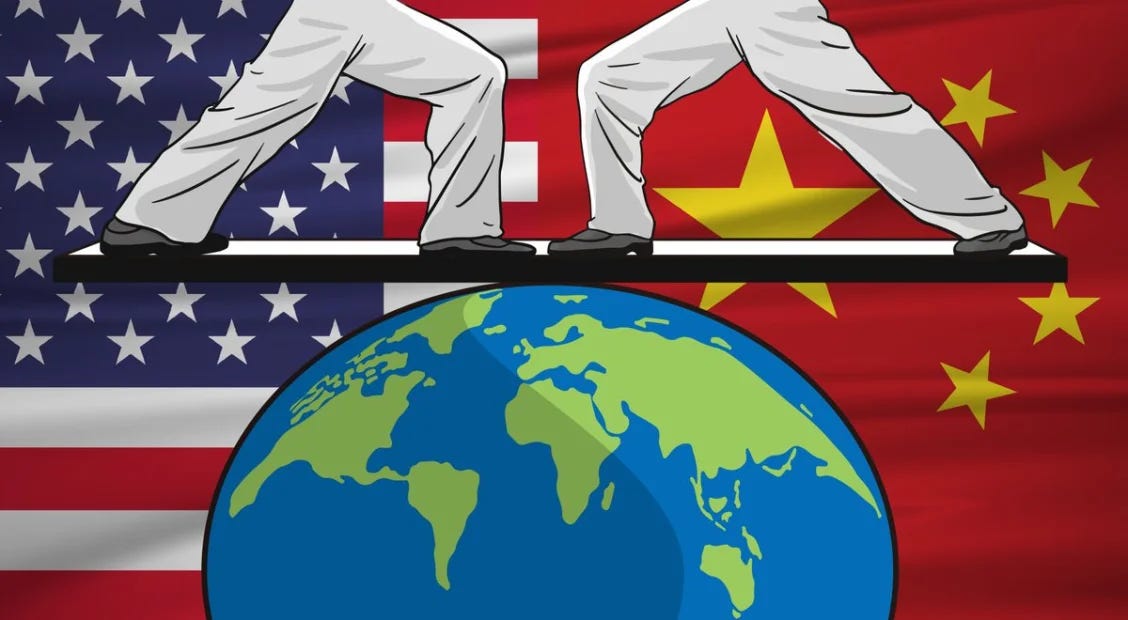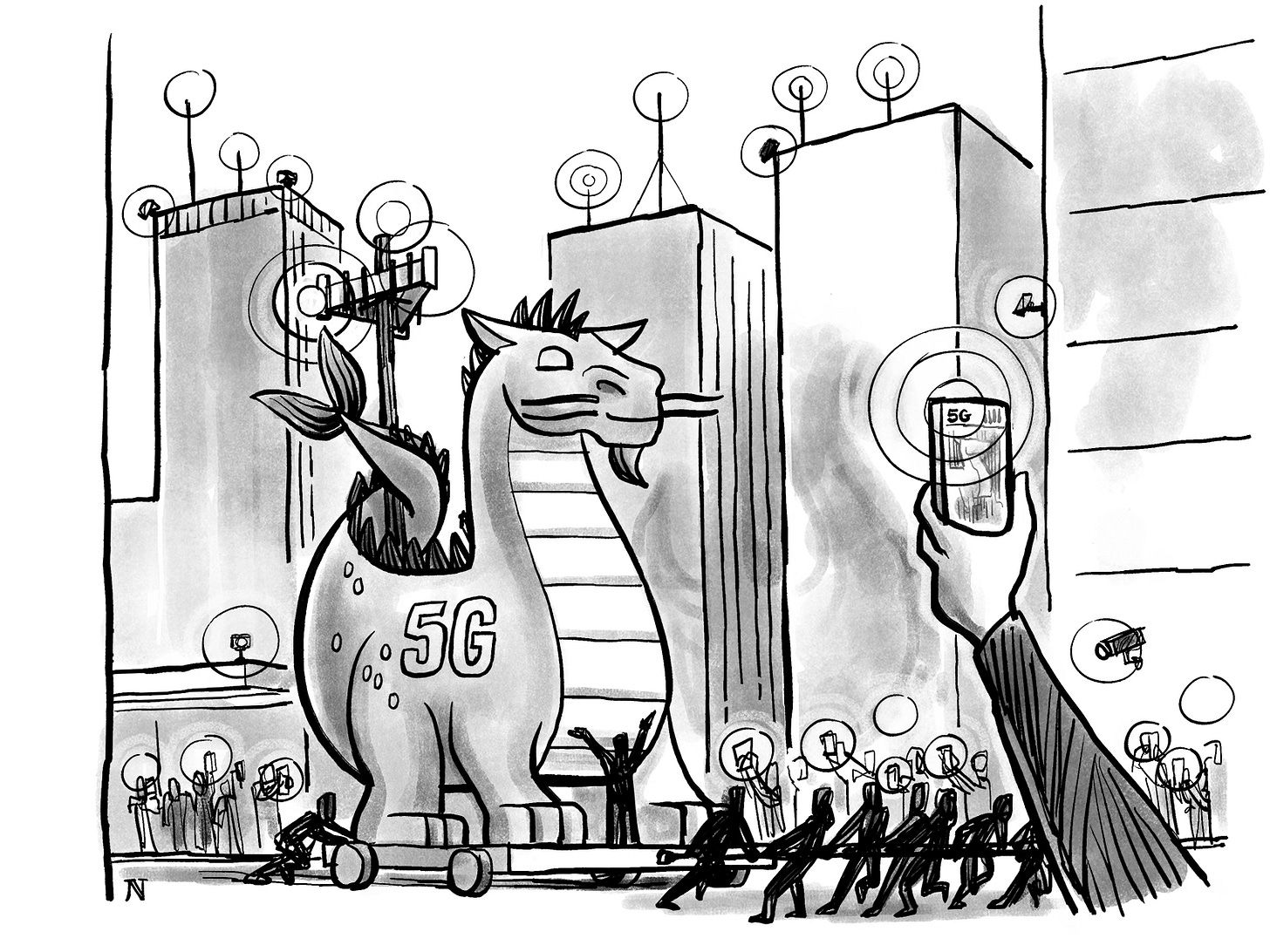The world is heading toward a stress-point (climate change) and a solution-point (AI, Singularity more generally) and a fundamental make-over point (demographic aging/peak humanity) — all while a majority global middle class emerges and instinctively needs … just about everything right as the planet plots to deny them just about everything.
That is a lot in play at one time, and a smart superpower wants to maintain access to it all.
But we are clearly in competition, within those superpower ranks. We have the democracies (US, EU), and we have autocracies (Russia, China), and we have the great “rubber match” that is India (tottering in both directions throughout its rise).
The deep need to “win” is our real enemy here. We can lead but we cannot win because — collectively — there is no win that does not include Russia and China — and not merely on our terms.
And yes, that is EXACTLY what “realism” looks like in the 21st century.
What we unleashed after WWII — this globalization we now fear — has moved humanity past the point of one side winning and the other side losing. That is the price of our success in making globalization truly global — along with true multipolarity (and the dreaded multikulti future we all face domestically). We promoted the benefits of connectivity and the free movement of things and people and technology — our American model of integration without peer, and now we have to accept the reality that multipolarity is not a threat but an opportunity — a joining of capabilities to deal with everything going on in our world right now.
Yes, we are suffering the backward-looking needs of Russia (empire) and China (irredentist longing for “lost lands”), but to interpret those clashpoints as guardrails for achievable global futures would be a huge mistake (Put away those blinders!). There is so much more at risk and so much more opportunity out there to grab for us to collectively settle for a brain-dead rerun of the Cold War.
And yet … we face just such a possibility — just such a path of least resistance (I recognize this situation! I know what is needed! We will prevail!).
We face decades of turbulence of the largely subnational, transnational, and international sorts — all of which diminish the utility and sacredness of borders, which is why we are so obsessed with borders right now.
We likewise carry in our collective memory this seeming “prime directive” of protecting state sovereignty at all cost — lest we replicate the horrors of last century’s world wars.
We are also built for that goal: our huge military with its global footprint and “responsibilities,” and we have fallen into the trap of thinking that our military might is what stands between us and tyranny (it does not; that’s what the Constitution is for, and please don’t ever forget that).
Now, many of us fear that our military might is the only thing standing between us and China’s world domination. That is similarly untrue, because our competition with China is one of leadership and attraction and integration — not war and subjugation (despite the painfully retrograde example of Putin).
We are competing with China to network this world, to 5G it, to AI it, to IoT it, to AIoT it — the whole shebang. Capture the hearts and minds of that majority global middle class and your system rules the world (not you, but your ruleset).
And here’s the good news: only our side can “win,” if that’s what you need to call it.
China’s ruling elite has only the slimmest hold on its own people (why else must it constantly surveil them?). It has zero capacity to subjugate the planet and they are too smart to even contemplate that path.
Instead, Beijing’s rulers want to convince the world that the escape from freedom that they offer is a safer, calmer, better bet for this tumultuous world future than any model the West can offer.
[See now where Explainable AI {XAI} can be so crucial?]
And, in the absence of us offering that better alternative (something connected but empowering and not Orwellian), China will “win” by default in the near-to-medium term even as their system is doomed for all the same reasons why tyranny has failed throughout history: it simply does not bring joy and fulfillment to the masses, whose paths to happiness are too many to count and thus require pluralistic politics — not THE answer but the never-ending search for answers.
So no, China cannot “win” and never will, but it can delay and deny a better future for much of the world IF we allow it to integrate the Global South unchallenged by our competition and ingenuity and leadership.
As I argue in America’s New Map:
American fears of a bifurcated technology world are legitimate. Beijing offers its cyber-sovereignty model amidst globalization’s ongoing consolidation of the goods trade, enabling it to lock in network supremacy across great swaths of the developing world. In so penetrating these states’ media ecosystems, Beijing seeks, in the words of longtime observer Joshua Kurlantzick, “to influence who gets selected as political leaders, what topics are discussed in those states’ domestic politics, how their universities approach issues related to China, and how their local media operates and covers many topics relating to Beijing.”
America ruled the several-steps-forward period of globalization’s rapid expansion (1990s–2000s) because its then-unparalleled consumption forced the global economy to revolve around its demand and tastes. But with China’s demographic dividend now being cashed out, globalization enters a one-step- backward regionalization phase triggered by East Asia’s transformation from the global economy’s “factory floor” to its preeminent demand hub.
Today, China occupies that same sweet spot that America enjoyed last midcentury when our combination of a vast domestic market and unmatched manufacturing capacity allowed us to promote national flagship companies as de facto global brands. By effectively capturing worldwide construction of 5G networks while successfully marketing both its BRI [Belt and Road Initiative] and associated city- security solutions, Beijing is poised to steer globalization’s next expansive phase. If America does not want to live in China’s world, we must—once again—carve out and propagate a competing integration model; otherwise we lose by default.
The challenge is clear, as is the worst alternative path:
The true danger that globalization now faces is a hard partitioning of its operating system on a bloc-by-bloc basis, replicating Cold War divisions. Here is the tricky thing to keep in mind: after globalization’s stunningly rapid expansion across the planet (1990s–2000s), the Great Recession naturally triggered a stabilizing re-regionalization or consolidation of those gains (e.g., the rise of new global demand centers like China). That many-steps-forward-and- one-step-back development is both natural and good. Every transformational process needs to take a breather now and then. The underlying danger today, as in all things political, would be in allowing that process to snowball into something destructively extreme (e.g., some new “iron curtain” dividing the Eurasian landmass between autocracies and democracies). Whenever humans are involved, nothing succeeds like excess.
In the Cold War era, two great blocs competed over which state-level operating system was superior: communism or capitalism. It was no contest. This time, the struggle will be over which model of multinational integration is superior, the question being which scheme offers (a) just enough security and certainty for that ascendant global middle class to feel comfortable amidst the turbulence generated by climate change and demographic transition, and (b) just enough freedom for that empowered group to politically rule itself—its natural, prideful inclination.
If the United States embraces this new superpower competition with gen- uine vigor and ingenuity, we will prevail. Despite our clear flaws, America possesses the most tested and proven ruleset as the world’s oldest multinational republic—now fifty members strong.
This is how I define both our present urgency and our present opportunity.
What triggers this mini-rant?
A fascinating bit from the World Economic Forum entitled: What's 'bi-globalization' and could this be the near future for geo-economics and global trade? (just out yesterday).
The report’s three depressing points:
'Geo-economic bi-globalization' is underpinned by the logic of geopolitical competition and reflects structural changes in international power.
The international system has evolved from the geopolitical unipolarity of the 1990s to a distinct bipolar power structure today.
The challenge now is to help manage coexistence in a situation of geo-economic competition.
What I don’t like about this pitch: it represents the West already giving up!
It implies an aging West in fearful decline, a China inexorably rising, an India apparently lost to the wrong side, and a Putinist Russia capable of no other path.
It represents the advanced economies throwing in the towel now! Just as the competition gets real.
And that is sad.
Not unexpected, but sad and unimaginative and certainly no serious response to the challenges and transformation facing our world today and tomorrow.
That path I noted disapprovingly above? The WEF says we’re already locked into it:
The global economy is being reshaped according to geopolitical fault lines. The post-Cold War economic globalization, driven by the logic of economic liberalization and free trade, has been replaced by geo-economic biglobalization, underpinned by the logic of geopolitical competition.
Paging Prof. Mackinder!
But what to expect from an elite still dominated by aging Boomers? They know what they know because they experienced what they experienced. To them, their childhood is more real than the present, which they are ready to write off as some “globalist” dream ( or worse, conspiracy).
Oh thee of little minds — and faith.
The piece starts off with a history very much similar to my own in ANM:
The post-Cold War unipolarity provided the perfect geopolitical environment for economic globalization. The USA enjoyed a rare moment of absolute primacy. The US geopolitical power shaped the global economy and paved the way for global economic integration. Geopolitical unipolarity offered stability and safeguarded the security of sea-lanes, vital for international trade flows. In concert with allies, institutions of global governance were universalized, guaranteeing the rules-based framework of the international trading order.
The World Trade Organization (WTO), established in 1995, was the product of that time of policies promoting multilateral trade liberalization and reforms among market economies.
But this is where the Chicken Little dynamic apparently kicks in:
Today’s geo-economic bi-globalization takes place in the shadow of geopolitical bipolarity. The USA-China bipolarity is restructuring the world economy. Geo-economics – geopolitical competition in the economic domain – will define the years to come. In a bipolar rivalry, great powers will view economic interdependency as geopolitical vulnerability. Instead of the universal promotion of market opening and international trade, two competing geo-economic strategies coexist in the process of geo-economic bi-globalization.
To me, this is surrender-monkey talk, but I will admit that it fits with our current America-First vibe, justifying its wall-building and our turning on our allies and trade partners while the getting is still good.
It’s just scary and depressing to see the WEF dabbling in such strategic fatalism (well, at least the title ended with a question mark).
And yet, the piece’s diagnosis of the two paths being taken by China and the US strikes me as dead-on:
The USA geo-economic strategy is the a mixture of decoupling economic ties with China via tariffs, trade barriers, and investment restrictions in strategic sectors and of defending the economy at home via industrial policies and subsidies.
China’s geo-economic strategy is the combination of decoupling via import substitution in technology manufacturing and other sectors and of diversifying its export and investment markets across different regions of the world. Both strategies employ industrial and trade policies. But they are geo-economic in nature. Their goal is to achieve a position of strategic advantage.
By the logic of those strategies, two spheres of geo-economic influence are forming.
I agree that the West is engaged in a defensive crouch while China is networking like crazy across the Global South via its BRI and “smart/safe city solutions” (the latter wheeled in like a 21st-century Trojan Horse).
But this is where the West is making a huge mistake:
This position on economic security seeks to rescue strategic independence from the economic interdependence of globalization.
That is a back-to-the-future mirage that dovetails nicely with MAGA but not jibe with, much less accommodate, much less enable the looming Singularity — even far less a coherent adaptation to climate change.
I mean, I get the instinct to secure what can be secured right now; I just believe that, if we are to usefully indulge that strategic instinct, we cast our most immediate nets to capture the entirety of the Western Hemisphere (my Americas-First ambition).
Of course, by indulging so deeply in MAGA fervor, anchored by its White Christian Nationalism, we rule out such ambitions, which is weird, because we in the Western Hemisphere are 80% Christian and 60% Catholic, so the hold-up here is really limited to just the White part. In truth, any such hemispheric integration would yield the same majority-minority status for Whites (45% across all the Americas now) as does our current demographic trajectory within these United States (~45% of Americans mid-century).
And here’s where we are slated to lose: by seeking “strategic independence from the economic interdependence of globalization,” we abandon the field of competition:
By contrast, China’s geo-economic strategy focuses on import substitution, seeking self-sufficiency in technology manufacturing and other sectors, and export substitution, diversifying from the US and other advanced markets.
It seeks both to build national economic resilience and to connect China to the rest of the world, particularly Eurasia and the Global South, including Africa and Latin America, through trade and investment arrangements, such as the Belt and Road Initiative and the Global Development Initiative. These are the seeds of another geo-economic sphere of influence.
This suggests a future in which America consolidates while China integrates. Again, no problem with the analysis, just with the giving-up-before-this-thing-really-gets-going vibe.
All of this is presented as basically a fait accompli — a fork in the road already taken.
To me, that’s nuts. European surrender-monkey nuts!
More smart analysis, albeit still in fatalistic mode:
Apart from the initial signs of geo-economic fragmentation, the IMF also shows the role of “non-aligned connector”, countries offering indirect links between blocs. It highlights the agency of other countries in trade policy decisions.
However the situation of “non-alignment” can only happen in loose bipolar systems. In the geopolitics of a tight bipolar system, the space and flexibility for connecting countries or swing states simply disappears. Not surprisingly, many multinational companies are anticipating the trend and already adopting bipolar structures, decoupling their global operations.
To me, these are globalization’s workarounds (proving flexibility), or its relief valves. The WEF view this more ominously, and I can’t blame them with Trump 2.0 only weeks away.
Now, the surrender-monkey instinct goes all-in on fatalism:
Irrespective of the evolution of the bipolar system, which is still contested, there seem to be some signs of impact on the international trading order – the institutions, rules, and principles regulating global trade. All signs indicate that the process of geo-economic bi-globalization will proceed without the stabilizing effects of multilateral institutions and binding rules.
I admit: at some point way too soon this coincidence morphs into causality.
The piece starts to wrap-up with the usual historical threats:
The historical precedent shows that international trade is not a guarantee of peace. After all, economic globalization and trade interdependence did not prevent the outbreak of World War I. However, fragmentation, less trade, and blocs did not provide more economic security. In fact, falling trade interdependence and protectionism preceded World War II.
Alright already!
At the end of the piece, the author shoves in a vague sort of let-this-not-be-so call for action (kind of ….?), suggesting it’s not to late to correct course:
A new world trading order has yet to be imagined and eventually established. It will be the product of leadership and statecraft, as well as a new equilibrium of powers and a common vision of the future.
Simply adapting to circumstances using the tenets of the previous order won’t fix the larger transformations reshaping the world. The challenge now is to buy some time. It is to help manage coexistence in a situation of geo-economic competition - and this is a significant diplomatic challenge by nature.
I like the buying-time notion. To me, that’s the basis of resistance to Trump 2.0’s worst instincts and manifestations.
As I always note: angry populism is what triggers progressive solutions — eventually. Trumpism is therefore a stage we must go through — and survive. It moves in the right direction (from too much of a market-making role for America to one more avowedly market-playing), but it goes too far — too crudely, and misses the opportunities for true global leadership, which, if it doesn’t come from us, it does not really come from anyone — sad to say.
Again, I have big problems with this piece and yet admire a lot of its analysis. I feel grateful to have come upon it, which is why I share it here today.






